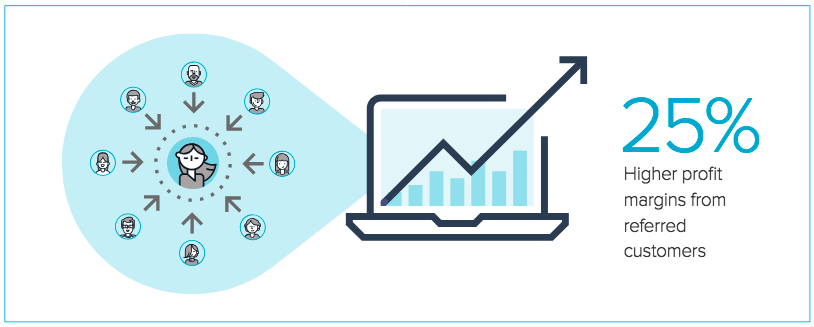It’s no shock that more and more businesses are investing in referral marketing these days, but executing like marketers running the best referral programs out there is no easy task. Especially since numerous research has shown that a well-executed referral program has the power to fuel higher conversion rates than any other channel1.
With so much data available to marketing leaders today, it is crucial to know the difference between acquisition channels and their impact on a variety of factors that impact brand exposure, engagement, conversion, and, ultimately, ROI. When you apply these learnings appropriately, you can create cohesive multi-channel strategies that embrace the strengths of each channel and amplify the likelihood of engaging, attracting, and acquiring new customers with greater efficiency.
For example, while referral marketing has a demonstrable ROI, it also tends to lower customer acquisition cost. By contrast, while email marketing also tends to generate a high ROI, its impact on customer acquisition costs tends to be static. Similarly, social media can be incredibly effective for driving brand awareness and engagement, but social traffic continues to convert at a relatively low rate.
So how can you best determine how referral marketing will impact your bottom line?
Don’t fret, we’re here to help with that.
Here’s a simple, three-step framework that’s designed to help both B2B and B2C companies calculate the costs associated with a referral program and compare those numbers against the expected return from referred customers.
Step 1: Compare Referral Program Cost Against New Customer Revenue
This is the easy step — and it’s the calculation that most marketers do.
At a high level, the goal here is to add up all of the “costs” associated with running your referral program. This might include investment in referral software, headcount to manage your program, and incentives paid out for approved referrals. Here’s a quick breakdown of how to calculate the latter two factors:
 The proportional cost of the person managing your referral program
The proportional cost of the person managing your referral program
Proportional is an important word here because most businesses don’t hire someone full-time to only run their referral program. So, the key here is to determine how much time someone spends managing your referral program and multiply that against their average hourly cost. For instance, if someone spends five hours per month managing your referral program and they cost you $35 per hour on average, it’s safe to estimate an annual cost of $2,100.
 Referral incentives
Referral incentives
This one’s easy. Let’s say you run an eCommerce company that offers $10 for every referral that results in a sale and you’re generating 1,000 of those per month, then the total annualized cost would add up to be $120,000.
While that second number might look large, there’s an important point to remember about referral incentive “costs” – they typically only cost you something when you’ve already closed new business.
So, if you’re a B2B company that sells solar power solutions and offers a $1,000 incentive for referred customers that install and pay for a $30,000 home solar system, then you’ll only pay the $1,000 incentive cost after you’ve already collected $30,000 in new revenue. This significantly limits your exposure to risk because it ensures that the vast majority of expenses will only be incurred if you’re actually converting and acquiring new customers.
Once you’ve calculated those costs and the new revenue they drove, generating a very basic ROI is simple: Add up total new revenue, divide it by total costs, and you’ll have your number.
Step 2: Factor in Average Customer Lifetime Value
While the calculation in Step 1 is the simplest way to calculate referral program ROI, companies that base ROI off a single purchase are leaving a very big variable out of the referral equation. Namely, the fact that referred customers tend to buy more, stay longer, and refer others — which means they’re often worth a lot more over time than non-referred customers.
One study of more than 10,000 customers over a 33-month period by the University of Pennsylvania’s Wharton School found that referred customers generated 25% higher profit margins and represented higher customer lifetime values (CLV) over customers acquired through other acquisition channels2.

So, what does this mean for calculating B2B and B2C referral program ROI?
While the Wharton School’s final calculation that referred customers are worth 25% more may not apply to every business and every industry, the data does point to a clear truth: Referred customers are worth more — and by a significant margin. And that margin — and the total value of a customer over time — must be factored into your referral marketing ROI calculation.
Here’s a very simplified way to do it, based on the Wharton School’s estimate that referred customers are worth 25% more:
1. Calculate your average Customer Lifetime Value across all channels
To do this, take your average sale price and multiply it by the number of purchases an average customer makes. For example, if you sell subscription boxes and the typical customer buys $120 worth of merchandise an average of 2.5 times over their relationship with your brand, then your CLV would be $300 ($120 x 2.5).
2. Multiply your CLV metric by 1.25
If we assume that referred customers are worth 25% more in CLV (per the Wharton School study mentioned above), you can use that number to generate a more accurate calculation of referral marketing ROI. To do this, take your CLV, multiply it by 1.25 (a representation of the 25% higher margin), and you’ll have a new CLV number. Using the subscription box example above, this would equate to $375 ($300 x 1.25).
3. Multiply that CLV number by the number of referrals you generate and divide it by your referral costs
If you generate 100 referrals in a month and each new customer is theoretically worth $375 (per the calculation above), then your referral revenue will be $30,750. If your cost per referral (the incentive you offer) is $20, then you can divide that total cost ($20 x 100 referrals = $2,000) by the total revenue number to calculate ROI.
It’s worth noting that this calculation can be applied to both B2B and B2C businesses.
Just as a yoga studio customer is likely to buy from a business multiple times, customers buying business services are often worth more than just their initial purchase amount. In fact, the Wharton School study found that referred B2B customers spend more than non-referred customers and are 18% less likely to churn. Knowing this, you can extrapolate that data to develop a clearer understanding of the ROI of your B2B referral marketing program.
So, if you sell software that costs $12,000 on an annual contract and your data suggests that the average customer renews twice, then your CLV would be $36,000. If you apply the Wharton School’s numbers to that equation, then you can assume that a referred customer’s CLV will be $45,000 ($36,000 x 1.25).
That number is the real benchmark you should be using to calculate ROI because it paints the truest proportional picture of new revenue to referral marketing cost. Over time, you can use the analytics in your referral marketing platform’s dashboard to develop a more accurate idea of how much more valuable referred customers are than their non-referred counterparts. This will lead to an even more accurate and informative ROI calculation.
Step 3: Evaluate Referral ROI Against Other Acquisition Channels
While the previous two steps should give you a good idea of how well your referral marketing program is performing, the value of that information is limited without the context of how referral marketing ROI stacks up against other acquisition channels.
Thankfully, this is relatively easy.
In all likelihood, you’re already tracking the ROI of channels like paid advertising and email marketing. If that’s the case, simply evaluate those numbers against the ones you generated above. When you do, ask yourself these questions:
1. How would ramping up investment in one channel impact customer acquisition cost overall?
2. Is investment in a particular channel scalable?
3. If you wanted to ramp up acquisition efforts in that channel, could you afford to do so?
4. If you increased investment in one channel, how would it impact the performance of another?
5. If you increased investment in one channel, how would it impact revenue and ROI?
The Best Referral Programs Are Managed By Data-Driven Marketers
All too often, marketers tend to overlook the fact that each platform and tactic is unique.
Some tactics are better suited for brand awareness, others for increasing sales, and others for driving engagement. While trying to demonstrate ROI, it’s important to provide context for the specific value that each channel delivers to your broader business goals.
Essential Metrics for Measuring Referral Program Success
When it comes to measuring the success of your referral program, focusing on the right metrics is key. Start by tracking the conversion rate, which tells you how many referred leads turn into paying customers. This metric helps you understand the effectiveness of your program in driving actual sales. Additionally, monitor the Customer Lifetime Value (CLV) of referred customers, as this indicates how much value these customers bring over time, providing insights into the long-term impact of your referral strategy.
Analyzing Referral Program Performance for Continuous Improvement
To continuously improve your referral program, it’s essential to regularly analyze your referral metrics. Look at the referral rate to understand how often your existing customers are referring new leads. Also, consider the cost per acquisition (CPA) for referred customers, which allows you to compare the efficiency of your referral program against other marketing channels. By combining these insights, you can fine-tune your strategies, allocate resources more effectively, and ultimately drive higher ROI from your referral efforts.
Unlock growth with referrals—request your free Ambassador demo today and see the impact firsthand!
[1] eMarketer
[2] Journal of Marketing: Referral Programs and Customer Value
